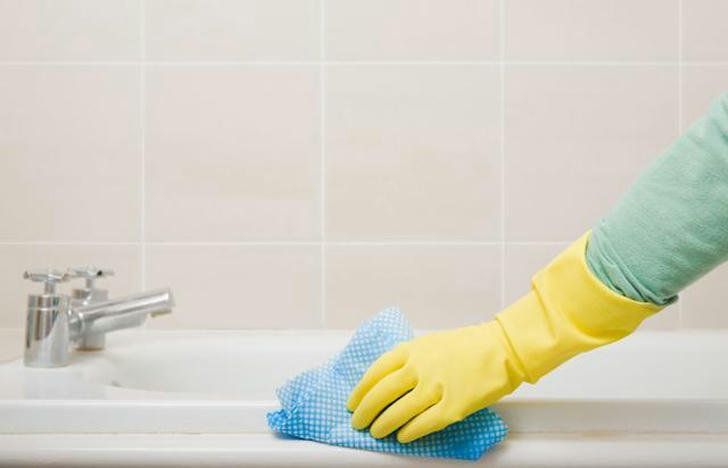Bathroom Limescale Won’t Budge? Two Simple Ingredients Can Solve It
You step into your bathroom expecting a relaxing shower, only to be greeted by cloudy glass doors, dull faucets, and stubborn white stains clinging to every surface. You scrub, rinse, repeat—but that crusty buildup just won’t go away.
Sound familiar? That’s limescale, a common mineral deposit caused by hard water. And while it may look harmless, it can damage your fixtures over time and make your bathroom feel perpetually dirty.
But here’s the good news: You don’t need expensive commercial cleaners or harsh chemicals to get rid of it. With just two basic ingredients—likely already in your kitchen—you can tackle even the toughest buildup safely, affordably, and effectively.
Let’s break down the science behind limescale, why it’s so persistent, and how this simple DIY solution can restore the sparkle to your bathroom.
💧 1⃣ What Exactly Is Limescale—and Why Won’t It Go Away?
Limescale is a chalky white substance primarily made of calcium carbonate, which forms when hard water evaporates and leaves behind mineral residue. It usually appears on:
- Faucets and showerheads
- Glass shower doors
- Bathroom tiles
- Toilets and sink bowls
- Kettles and water heaters
Why is it hard to clean?
Because calcium carbonate is alkaline, it resists many basic soaps and detergents. Simply wiping it down doesn’t work. Over time, it hardens like cement, binding to surfaces and requiring an acidic cleaner to break it down.
❗Note: Commercial descalers can be effective, but many contain harsh acids or synthetic chemicals that can irritate skin or damage delicate surfaces.
That’s where natural acids come in—and the two ingredients you need are white vinegar and baking soda.
🧪 2⃣ The Two-Ingredient Solution: Vinegar + Baking Soda
This dynamic duo is more than a school science experiment. When used correctly, white vinegar (acidic) and baking soda (alkaline) form a fizzing reaction that lifts stains, dissolves buildup, and penetrates tight spaces.
Here’s how each ingredient works:
- White vinegar (acetic acid) breaks down limescale by reacting with calcium carbonate, dissolving it into a water-soluble form you can easily wipe away.
- Baking soda adds gentle abrasiveness to help scrub away residue and neutralizes odors.
When combined, the bubbling action physically loosens grime while the chemistry dissolves it.
🧼 3⃣ How to Use This Combo for Maximum Effectiveness
✨ For Showerheads and Faucets:
What you need:
- 1 cup white vinegar
- ½ cup baking soda
- A plastic bag and rubber band (or zip tie)
Steps:
- Fill a plastic bag halfway with vinegar and a spoonful of baking soda.
- Quickly place the bag over the showerhead or faucet spout so it’s submerged.
- Secure with a rubber band.
- Let it soak for 30–60 minutes.
- Remove the bag and scrub gently with an old toothbrush.
- Rinse with warm water and wipe dry.
Why it works: The acetic acid dissolves mineral buildup inside and outside the fixture, restoring water pressure and shine.
🧽 For Glass Doors and Tiles:
What you need:
- 1 cup white vinegar
- ½ cup baking soda
- Spray bottle and soft sponge or microfiber cloth
Steps:
- Spray vinegar directly onto the surface and let it sit for 10 minutes.
- Sprinkle baking soda on a damp sponge.
- Scrub the surface in circular motions.
- Let the mixture sit for another 5–10 minutes.
- Rinse thoroughly with warm water.
- Buff dry with a clean cloth for a streak-free finish.
Tip: For stubborn buildup, repeat the process weekly until clear.
🚽 For Toilets and Sink Bowls:
- Pour 1 cup vinegar into the bowl and let it sit for 10–15 minutes.
- Sprinkle in ½ cup baking soda.
- Scrub with a toilet brush or sponge.
- Let fizz and soak for another 10 minutes.
- Flush or rinse thoroughly.
This method works wonders on the hard ring stains and improves odor too.
🧠 4⃣ The Science Behind the Fizz
When vinegar (acetic acid) meets baking soda (sodium bicarbonate), they undergo an acid-base reaction that produces carbon dioxide gas. This fizzy bubbling is not just for show—it:
- Lifts stubborn grime from porous surfaces
- Breaks chemical bonds in hardened mineral layers
- Helps carry dissolved limescale away from surfaces
And best of all, it’s non-toxic, making it safe for use around children, pets, and people with chemical sensitivities.
🛠️ 5⃣ Quick Guide: Where and How to Apply
| Area | Application Tip | Frequency |
|---|---|---|
| Showerhead | Soak in a vinegar-filled bag | Every 1–2 months |
| Bathroom tiles | Scrub with baking soda + vinegar spray | Weekly |
| Faucet aerators | Detach and soak overnight | Monthly |
| Glass doors | Spray + scrub, then squeegee dry | 2x per week |
| Toilet bowl | Pour, fizz, scrub | Weekly |
🚫 6⃣ What NOT to Do
While vinegar and baking soda are safe for most uses, avoid these common mistakes:
- Don’t use on natural stone like marble or granite—vinegar can etch the surface.
- Don’t mix with bleach—combining vinegar with bleach produces toxic chlorine gas.
- Avoid using metal brushes—they can scratch surfaces and trap bacteria.
Always spot-test on a small area first if you’re unsure.
✅ Final Thoughts: Clean Smart, Not Hard
Limescale may be persistent, but it’s not invincible. Armed with just two simple kitchen staples, you can transform your bathroom from dull and crusty to fresh and gleaming—without spending a dime on chemical cleaners.
This isn’t just about aesthetics; cleaning limescale also improves water efficiency, protects your fixtures, and extends the lifespan of plumbing systems.
By incorporating vinegar and baking soda into your regular cleaning routine, you create a low-cost, eco-friendly, and highly effective method to keep your bathroom in top shape.
So next time you're ready to wage war on bathroom buildup, skip the expensive cleaners—and go for the fizz.

